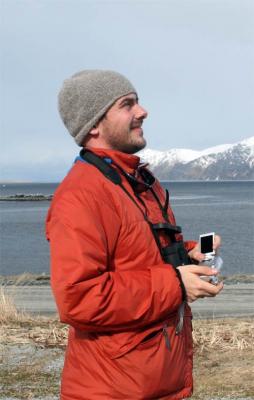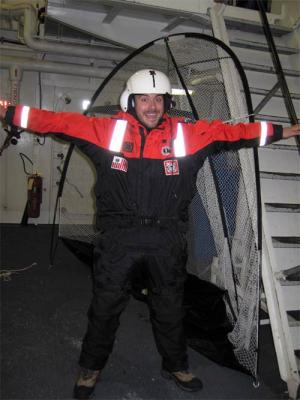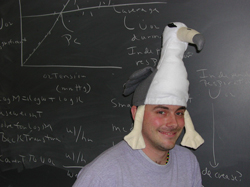During this scientific mission to the ice pack of the Bering Sea, I have met many new creatures. Let me introduce you to yet one more.
**Dr. David Hyrenbach
Scientific name: *Hyrenbachia daveediosus PhD***
Where does Dr David live? Dr. David lives in Greenlake, slightly north of down-town Seattle. In the summertime he migrates down to central California to rendezvous with black-footed albatross. During the school year he forages around the University of Washington.

How many Hyrenbachs are there? Just him. He is an only child, however, there are close species in Spain and in France.
What are Dr. David’s identifying characteristics? David is an exemplary teacher. He is able to take complex ideas and explain them to others. He hangs out with Carleton, the walrus puppet. He is often seen carrying binoculars and on Sundays he wears his green penguin shirt.

What does he eat? David totally enjoys curry and coffee. He consumes bananas and his favorite vegetable is bok choy with tofu and soy sauce. Mahi mahi is one of his favorite fish to eat.
How was Dr. David educated? He went to high school in Spain. At 17, he was a YFU (Youth for Understanding) exchange student in Saint Paul, Minnesota. After that, he went to the University of California San Diego and earned a Bachelor degree and PhD in ecology and oceanography. Then he went to the Duke University Marine Laboratory in North Carolina. In 2005, he returned to the west coast to the University of Washington.
How old is he? Dr. David has lived 37 years; longer than a ribbon seal. His main predators are mosquitoes, viruses, and possibly zombies. There seems to be little interaction between him and cigarettes or any tobacco products

Do you know what is really cool about Dr. David Hyrenbach? He owns an albatross hat that his mother has made for him. It comes in very handy when he has to pick up other species at the airport.
He moves about the city by bus or by flex car. He really likes the flex cars because they are mostly hybrid cars and are gentle on gasoline.
He enjoys silly walks, especially when he launches from the curb.
Dr. David likes to hang out at the arboretum. He frequents Freemont, where there is a large troll statue that is of great interest to him.
Dr. David has a commensal relationship with Chorbiken, the beanie baby.
Why do we know so little about Dr. David Hyrenbach? Dr. David is an elusive being. He is always running around. The only place he sits is in his office. The best way to find him is by e-mail.
Take the Dr. David Hyrenbach quiz! Write the number of the question with the letter of the best answer on any ‘Ask the Team’ comment form. Make sure to include your name ? Thanks!
Which of the following is true?
a. David drives his big SUV smoking a cigarette on his way to work. b. David works at a circus training chickens to play the piano c. David thinks the Bering Sea is boring d. None of the above
Which of the following animals is David’s favorite?
a. cockroach b. centipede c. Black footed albatross d. mosquito
What would David order from the following menu?
a. seal steak b. steak tartar c. spoiled milk d. mahi-mahi
What does Dr. David like to do more than anything else in the whole wide world?
a. Make money b. Teach the next generation to be stewards of their environment c. Smoke cigarettes d. Super glue his fingers together
Why has David spent two years coordinating the BEST (Bering Sea EcosystemAn ecological community together with its environment, functioning as a unit. Study) program?
a. So he can make money to buy cigarettes b. To understand how the Bering Sea EcosystemAn ecological community together with its environment, functioning as a unit. will respond to global warming. c. To find the Seattle Seahawk. d. To put on MS 900 survival suits


Comments